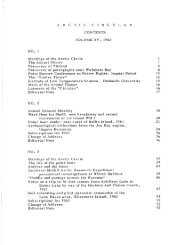Volume 11, 1958 - The Arctic Circle - Home
Volume 11, 1958 - The Arctic Circle - Home
Volume 11, 1958 - The Arctic Circle - Home
Create successful ePaper yourself
Turn your PDF publications into a flip-book with our unique Google optimized e-Paper software.
VOL. XI No.4<br />
THE ARCTIC CIRCULAR<br />
61<br />
In <strong>1958</strong> Mr. Phipps had equipped his aircraft with very<br />
large low.pressure tires ( 5 lb. pressure; 25 X <strong>11</strong> X 4-inch) for<br />
landing on rough terrain. <strong>The</strong>se proved very satisfactory. With<br />
the large tires the cruising speed of the 150 h.p. Lycoming engine<br />
was reduced from <strong>11</strong>5 m.p.h. to 95 m.p.h. <strong>The</strong> fuel tanks on the<br />
aircraft normally carry 30 gallons which at the average gasoline<br />
consumption of 6 1/2 gallons per ho\\r gives a range of about 400<br />
miles. For the flight north an extra fuel tank was added in the<br />
form of a 45-gallon drum, so arranged that fuel could be pumped<br />
into the wing tanks in flight, increasing the range to 1,000 miles.<br />
<strong>The</strong> take-off run of the aircraft is about 200 feet and the landing<br />
roll is somewhat greater, both distances depending very much on<br />
wind speed. In Canada the aircraft is licensed to carry a<br />
disposable load of 700 pounds.<br />
During the operation radio communication was maintained<br />
between the aircraft and the weather stations at Resolute and Mould<br />
Bay and daily flight plans were filed. In addition a 2-watt radio set<br />
at the base camp permitted intermittent contact with the aircraft<br />
and the weather stations. Emergency and survival equipment was<br />
carried on all flights, which totalled 300 flying hours. <strong>The</strong><br />
performance of the aircraft throughout was most satisfactory and<br />
there were no mishaps; on six occasions it became mired on<br />
landing but it seldom sank deeper than the height of the hubs and one<br />
man lifting on the wing strut while the other built a support of rocks<br />
under the tires was sufficient to extricate the machine.<br />
<strong>The</strong> 300 hours flown include the flight from Carp to<br />
Resolute and return, about 60 hours. Approximately 450 landings<br />
were made du:.-ing the investigation of which about 400 were on<br />
unprepared surfaces, involving 249 different places. One hundred<br />
and sixty of these places were on Melville Island, 29 on Mackenzie<br />
King Island, 27 on Prince Patrick Island, 15 on Borden Island,<br />
10 on Eglinton Island, 4 on Brock Island, 3 on Cameron Island,<br />
and 1 on Emerald Ioland.<br />
Belcher Islands. <strong>The</strong> geological reconnaissance of these<br />
islands was initiated by G.D. Jackson. His party was flown from<br />
• Moosonee on June 19 in a Canso aircraft of Austin Airways Ltd.,<br />
and brought back in the same manner On September 16. <strong>The</strong> eastern<br />
part of the Belcher Islands group wa.s examined and also several<br />
I<br />
of the clusters of small islands lying to the north,including the<br />
Bakers Dozen. T;,e party used the services of local Eskimo and<br />
a whale boat but were not able to travel as much as they had hoped












